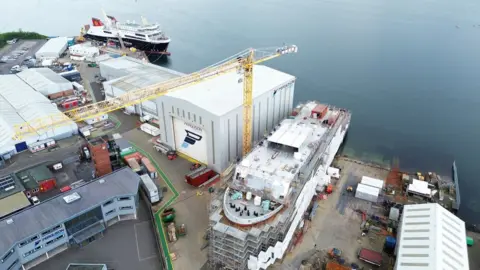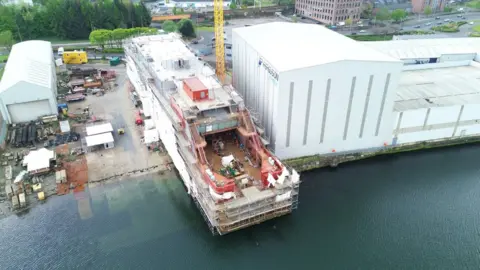Ferry to be built at Ferguson yard despite not being 'value for money'
 Christopher Brindle
Christopher BrindleMinisters will continue funding the construction of a second ferry at Ferguson shipyard despite it being cheaper to build a new ship elsewhere.
Economy Secretary Neil Gray said a review had found finishing the ship, known as Hull 802, did not represent value for money in "narrow" terms.
But he said completing the vessel at the nationalised yard was the fastest way of delivering more ferry capacity.
Pulling the plug would also threaten jobs and the wider economy, he added.
Mr Gray has issued a rarely-used ministerial direction to overrule the financial test.
Two CalMac ferries were ordered in 2015 when Ferguson Marine was owned by Jim McColl, a pro-independence businessman who had rescued the Port Glasgow yard from administration a year earlier.
The build soon ran into trouble - and the ships are now more than £200m overbudget and six years late. Mr McColl and the government-owned ferry procurement agency CMAL blame each other for the problems.
The current boss of the shipyard - which was nationalised in 2019 - now expects the first ship, Glen Sannox, to be delivered this autumn, followed by the as-yet unnamed Hull 802 in the late summer of 2024.
Mr Gray told MSPs that a "due diligence" review of requests for additional funding had found that completing Glen Sannox at the yard was the "cheapest option open to ministers".
But he continued: "The case for vessel 802 is more challenging - and I have accepted the judgement of the Scottish government accountable officer that the narrow value for money case has not been made."
 Christopher Brindle
Christopher BrindleThe minister, however, said it was important to look at wider considerations including the impact on the shipyard, the wider community and national resilience.
"These are not matters that can be taken into account in a pure value for money exercise but clearly they are matters of the utmost importance," he said.
While the value for money assessment had concluded it could be cheaper to procure a new ferry elsewhere, that would lead to significant delays, as it could not be deployed before at least May 2027, he said.
"I do not consider it acceptable for our island communities to wait this further period," he said.
The repeated delays in the delivery of Glen Sannox and Hull 802 have had a major impact on the resilience of the ageing CalMac fleet, which has been hit by frequent breakdowns and soaring maintenance costs.
Last year a BBC Scotland documentary - The Great Ferries Scandal - presented evidence that the procurement process may have been rigged in favour of Ferguson Marine.
The investigation also questioned the quality of the design presented by Ferguson, even though it was given top marks by CMAL's evaluators. CMAL has denied any impropriety.
Mr Gray told MSPs he could not rule out further increases in costs for the two ferries because the shipyard was facing inflationary pressures and was still discovering "design gaps", some of which dated back many years.
Scottish Labour MSP Alex Rowley said what was missing from Mr Gray's statement was an apology.
"An apology to the islanders who have been so badly let down, an apology to the workers at Ferguson who have been so badly let down - and ultimately an apology to the people of Scotland for outrageous mismanagement of public funds," he said.
For the Scottish Conservatives, Graham Simpson said: "The building of ferries 801 and 802 has been a shambles from start to finish.
"In fact, shambles is not a strong enough word. It has been a scandal."


By his opponents' calculation, Neil Gray is the eighth minister to take responsibility for the CalMac ferry-building contract at Ferguson shipyard. He must hope he'll be the last, but he's off to a difficult start.
"Due diligence" is business-speak for checking out the prospects, liabilities and risks. Now complete, the cabinet secretary's admission that the second of the ferries no longer provides value for money is embarrassing, and a hostage to further misfortune.
Convention requires that a civil service "accountable officer" can be held responsible for releasing government funds, and must be able to tell auditors that spending provides value for money.
Following that due diligence, Gregor Irwin, the director-general for economy in the Scottish government, cannot do that on the second hull. So he has written to his political boss, Neil Gray, saying he will have to give written permission to over-ride that rule. It's a way of saying: "No minister, you're on your own with this."
Mr Gray has done so, wanting to give the shipyard a chance to succeed after this calamitous contract. Admitting defeat would surely sink the yard, and lose 340 jobs. Further contracts will require further investment, so the Scottish government is now considering the use of even more scarce public funds.
Former business minister Ivan McKee also hinted at discussions he must know something about, on selling the yard or entering a joint venture with a private company which could deploy it for the renewable energy boom.
The risk to jobs on the Clyde and Hebridean islands, because the CalMac fleet is old, unreliable and under-capacity, is on a far greater scale than the jobs at stake in Port Glasgow.
That leads to the other justification: the prospect of an alternative procurement meaning a further delay for islanders, estimated at 30 months beyond the current (though hardly reliable) delivery date for Hull 802.
What's missing is the new cost. Officially, the bill stands at £203m, of which £105m is for Hull 802. That's over and above the original £97m contract price.
Having only £6m contingency margin is very low for such a project. The Scottish government sunk more than £50m more into the yard when it drove the previous owners into administration.
Asked at Holyrood about updated costings, Mr Gray declined to say. It seems the yard's chief executive will now have to tot up the bill, including increased costs of supplies.
So either Neil Gray is not admitting how much more the ships are on course to cost, or he doesn't know. And if he doesn't know, how could he know that the project has failed its "value for money" test, or how much more money is being risked, by a decision that the civil service can no longer justify?
